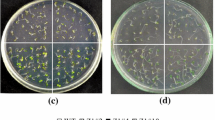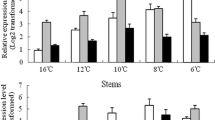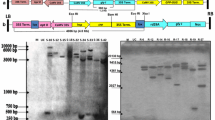Abstract
Plant glutathione S-transferases (GSTs) are involved in protecting plants against both diverse biotic and abiotic stresses. In the present study, a novel GST gene (LbGST1) was cloned from Limonium bicolor (Bunge) Kuntze (Plumbaginaceae). To characterize its function in salt tolerance, tobacco lines transformed with LbGST1 were generated. Compared with wild-type (WT) tobacco, transgenic plants overexpressing LbGST1 exhibited both GST and glutathione peroxidase activities. Moreover, superoxide dismutase, peroxidase (POD), and catalase activities in transgenic plants were significantly higher than those in WT plants, particularly when grown under conditions of salt stress. Similarly, levels of proline in transgenic plants were also higher than those in WT plants grown under NaCl stress conditions. Whereas, Malondialdehyde contents in transgenic plants were lower than those in WT plants under NaCl conditions. Furthermore, Na+ content in transgenic plants was lower than that in WT plants under these stress conditions. Subcellular localization analysis revealed that the LbGST1 protein was localized in the nucleus. These results suggested that overexpression of LbGST1 gene can affect many physiological processes associated with plant salt tolerance. Therefore, we hypothesize that LbGST1 gene can mediate many physiological pathways that enhance stress resistance in plants.






Similar content being viewed by others
Abbreviations
- bp:
-
base pair
- CAT:
-
catalase
- GPX:
-
glutathione peroxidase
- GST:
-
gluthathione S-transferase
- GFP:
-
green fluorescent protein
- MDA:
-
malondialdehyde
- RLG:
-
relative rate of length growth
- PCR:
-
polymerase chain reaction
- POD:
-
peroxidase
- SOD:
-
superoxide dismutase
- WT:
-
wild type
References
Bailly C (2004) Active oxygen species and antioxidants in seed biology. Seed Sci Res 14:93–107
Dixon DP, Lapthorn A, Edwards R (2002a) Plant glutathione transferases. Genome Biol 3:3004.1–3004.10
Dixon DP, Davis BG, Edwards R (2002b) Functional divergence in the glutathione transferase superfamily in plants. J Biol Chem 277:30859–30869. doi:10.1074/jbc.M202919200
Edwards R, Dixon DP, Walbot V (2000) Plant glutathione S-transferases: enzymes with multiple functions in sickness and in health. Trends Plant Sci 5:193–198. doi:10.1016/S1360-1385(00)01601-0
Edwards R, Dixon DP (2005) Plant glutathione transferases. Methods Enzymol 401:169–186
Frova C (2003) The plant glutathione transferase gene family: Genomic structure, functions, expression and evolution. Physiol Plant 119:469–479
Kampranis SC, Damianova R, Atallah M, Toby G, Kondi G, Tsichlis PN, Makris AM (2000) A novel plant glutathione S-transferase/peroxidase suppresses Bax lethality in yeast. J Biol Chem 275:29207–29216. doi:10.1074/jbc.M002359200
Kim YH, Lim S, Han SH, Lee JC, Song WK, Bang JW, Kwon SY, Lee HS, Kwak SS (2007) Differential expression of 10 sweetpotato peroxidases in response to sulfur dioxide, ozone, and ultraviolet radiation. Plant Physiol Biochem 45:908–914. doi:10.1016/j.plaphy.2007.07.019
Lim JD, Hahn SJ, Yu CY, Chung I (2005) Expression of the glutathione S-transferase gene (NT107) in transgenic Dianthus superbus. Plant Cell Tiss Org 80:277–286. doi:10.1007/s11240-004-1032-6
Kishor P, Hong Z, Miao GH, Hu C, Verma D (1995) Overexpression of [delta]-pyrroline-5-carboxylate synthetase increases proline production and confers osmotolerance in transgenic plants. Plant Physiol 108:1387–1394
Liu XF, Li JY (2002) Characterization of an ultra-violet inducible gene that encodes glutathione S-transferase in Arabidopsis thaliana. Acta Genetic Sinica 29:458–460
Mylona PV, Polidoros AN, Scandalios JG (2007) Antioxidant gene responses to ROS-generating xenobiotics in developing and germinated scutella of maize. J Exp Bot 58:1301–1312. doi:10.1093/jxb/erl292
Obata T, Kitamoto HK, Nakamura A, Fukuda A, Tanaka Y (2007) Rice Shaker Potassium Channel OsKAT1 Confers tolerance to salinity stress on yeast and rice cells. Plant Physiol 144:1978–1985. doi:10.1104/pp.107.101154
Roxas VP, Smith RK Jr, Allen ER, Allen RD (1997) Overexpression of glutathione S-transferase/glutathione peroxidase enhances the growth of transgenic tobacco seedlings during stress. Nat Biotechnol 15:988–991. doi:10.1038/nbt1097-988
Roxas VP, Lodhi SA, Garrett DK, Mahan JR, Allen RD (2000) Stress tolerance in transgenic tobacco seedlings that overexpress glutathione S-transferase/glutathione peroxidase. Plant Cell Physiol 41:1229–1234
Silva-Ortega CO, Ochoa-Alfaro AE, Reyes-Agüero JA, Aguado-Santacruz GA, Jiménez-Bremont JF (2007) Salt stress increases the expression of p5cs gene and induces proline accumulation in cactus pear. Plant Physiol Biochem 46:82–92. doi:10.1016/j.plaphy.2007.10.011
Sunkar R, Bartels D, Kirch HH (2003) Overexpression of a stress inducible aldehyde dehydrogenase gene from Arabidopsis thaliana in transgenic plants improves stress tolerance. Plant J 35:452–464. doi:10.1046/j.1365-313X.2003.01819.x
Takesawa T, Ito M, Kanzaki H, Kameya N, Nakamura I (2002) Over-expression of glutathione S-transferase in transgenic rice enhances germination and growth at low temperature. Mol Breed 9:93–101
Tester M, Davenport R (2003) Na+ tolerance and Na+ transport in higher plants. Ann Bot 91:503–527
Verdoy D, Coba De La Peña T, Redondo FJ, Lucas MM, Pueyo JJ (2006) Transgenic Medicago truncatula plants that accumulate proline display nitrogen-fixing activity with enhanced tolerance to osmotic stress. Plant Cell Environ 29:1913–1923. doi:10.1111/j.1365-3040.2006.01567.x
Wang Y, Ma H, Liu G, Zhang D, Ban Q, Zhang G, Xu C, Yang C (2008) Generation and analysis of expressed sequence tags from a NaHCO3-treated Limonium bicolor cDNA library. Plant Physiol Biochem 46:977–986. doi:10.1016/j.plaphy.2008.06.001
Yu T, Li YS, Chen XF, Hu J, Chang X, Zhu YG (2003) Transgenic tobacco plants overexpressing cotton glutathione S-transferase (GST) show enhanced resistance to methyl viologen. J Plant Physiol 160:1305–1311. doi:10.1078/0176-1617-01205
Acknowledgments
This work has been supported by Program for New Century Excellent Talents in University (NCET-08-0751), Foundation for the Author of National Excellent Doctoral Dissertation of China (200973), and Science foundation of Northeast Forestry University (09040).
Author information
Authors and Affiliations
Corresponding author
Rights and permissions
About this article
Cite this article
Diao, G., Wang, Y., Wang, C. et al. Cloning and Functional Characterization of a Novel Glutathione S-Transferase Gene from Limonium bicolor . Plant Mol Biol Rep 29, 77–87 (2011). https://doi.org/10.1007/s11105-010-0212-2
Published:
Issue Date:
DOI: https://doi.org/10.1007/s11105-010-0212-2




